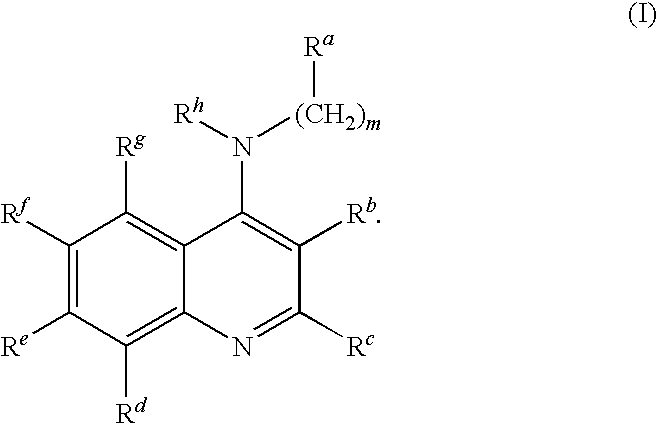4-aminoquinoline compounds for treating virus-related conditions
a technology of aminoquinoline and virus, applied in the field of aminoquinoline compounds, can solve the problems of limited, if any, therapeutic options available, and high level of sickness and mortality associated with hcv, and achieve the effects of improving the safety and efficacy of hcv treatment and improving the safety of hcv treatmen
- Summary
- Abstract
- Description
- Claims
- Application Information
AI Technical Summary
Benefits of technology
Problems solved by technology
Method used
Image
Examples
example 1
Compounds and Antiviral Activity
[0186]In the following examples, compounds of the present invention were evaluated for antiviral activity against HCV, RSV, WNV, YFV, DNG, EBOV, and SINV.
[0187]In conducting the experiments, stock solutions of the antiviral compounds were prepared at a concentration of 10 mM in DMSO. Dilutions were made to screening concentrations in cellular growth media. Compounds were initially tested at 25 μM final concentration in primary screening tests, and subsequently tested at a range of from 75 μM to 0.75 μM final concentration in secondary screening tests. The compounds were added to cells and incubated for 24 hours at 37° C. and 5% CO2 (v / v).
[0188]The methods for measuring antiviral activity and cell toxicity are described below in Examples 2-9. The results of primary screening tests are shown in Table 3 as percent inhibition of viral replication for each of the compounds tested. The results of secondary screening tests are shown in Tables 4 and 5 as EC50...
example 2
Measurement of HCV Antiviral Activity
[0189]HCV antiviral activity was measured in a HCV Neo screening assay by determining HCV replicon reduction effects of compounds through NPTII ELISA quantitation of Neomycin Phosphotransferase levels.
[0190]Clone A cells, a clone of a human hepatoma-derived cell line (Huh7) which carries constitutively replicating subgenomic hepatits C virus RNA, were plated in 96 well tissue culture treated microplates and allowed to settle for 4 hours at 37° C. and 5% CO2 (v / v). Test compounds were added to appropriate final concentration with DMSO concentration being held constant at 1% in all wells. No compound controls consisted of cells with media plus DMSO at 1%. Background control wells were cells treated with 150U Interferon alpha in media plus DMSO at 1%. Cells were incubated in the presence of compound for 24 hours at 37° C. and 5% CO2 (v / v).
[0191]Neomycin Phosphotransferase II protein was quantified using NPTII ELISA assay kit (Agdia, Inc. of Elkhart,...
example 3
Measurement of RSV Antiviral Activity
[0192]RSV antiviral activity was measured against a RSV minigenome-dependent β-galactosidase expression assay (RSV β-Gal). Cis-acting elements are required for the replication and transcription of a number of negative-strand virus genomes. This requirement can be utilized to develop methods for identifying antiviral compounds. Applicants have applied such methods to, for example, RSV to develop a prototype assay for detecting and quantifying negative-strand RNA viruses. See Olivo et al., “Detection and quantitation of human respiratory syncytial virus (RSV) using minigenorne cDNA and a Sindbis virus replicon: a prototype assay for negative-stranded RNA viruses,” Virology 251:198-205 (1998). In addition, synthetic analogs of genomic RNA have been developed. See Collins et al., “Rescue of synthetic analogs of respiratory syncytial virus genomic RNA and effect of truncations and mutations on the expression of a foreign reporter gene,”Proc. Natl. Aca...
PUM
| Property | Measurement | Unit |
|---|---|---|
| surface area | aaaaa | aaaaa |
| v/v | aaaaa | aaaaa |
| Rh | aaaaa | aaaaa |
Abstract
Description
Claims
Application Information
 Login to View More
Login to View More - R&D
- Intellectual Property
- Life Sciences
- Materials
- Tech Scout
- Unparalleled Data Quality
- Higher Quality Content
- 60% Fewer Hallucinations
Browse by: Latest US Patents, China's latest patents, Technical Efficacy Thesaurus, Application Domain, Technology Topic, Popular Technical Reports.
© 2025 PatSnap. All rights reserved.Legal|Privacy policy|Modern Slavery Act Transparency Statement|Sitemap|About US| Contact US: help@patsnap.com



